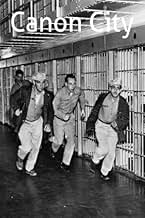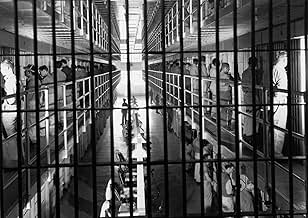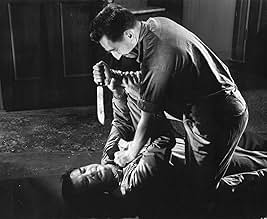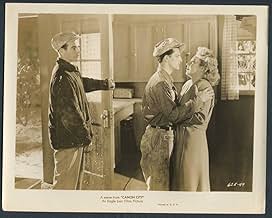IMDb-BEWERTUNG
6,5/10
472
IHRE BEWERTUNG
Füge eine Handlung in deiner Sprache hinzuTwelve inmates plan a prison break from the Colorado State Penitentiary but one of them reluctantly joins the group.Twelve inmates plan a prison break from the Colorado State Penitentiary but one of them reluctantly joins the group.Twelve inmates plan a prison break from the Colorado State Penitentiary but one of them reluctantly joins the group.
Reed Hadley
- Narrator
- (Synchronisation)
Empfohlene Bewertungen
Directed by veteran film-maker Crane Wilbur this rousing prison story is based on actual events that occurred at the Canon City penitentiary in Colorado in 1947.Newcomer Scott Brady is excellent as a convict who,caught up in events, must join in with eleven other escapees.As the fast-paced film-noir unfolds,each event is chronicled by that wonderful narrator Reed Hadley in semi-documentary fashion.A fine cast of character actors round out the cast; Jeff Corey as the ruthless convict leader,Stanley Clements,Robert Bice,and ( against type) Whit Bissell as a nervous killer.Actress Mabel Paige is particularly good as a very brave housewife.This film is another great example of Eagle-Lion pictures during that corporation's short run.
For anyone who enjoys mid-20th century movies, "Canon City" is a perfect choice. I had the good fortune to watch this movie in the wee hours of the morning, when old black-and-white movies are best viewed. Tension abounds in this surprisingly gripping story. That it's based on real events and filmed on location is a plus. If you have ever visited the Royal Gorge Bridge and tram in Colorado, you will enjoy the cat-and-mouse chase scene near the end of the movie. The women are heroic in this film, much more so than the men. With their calming words, warm food, hot cocoa, and hammer-wielding ways, they demonstrate courage in the face of danger. "Star Trek" fans will find a treat in the prisoner known as Smalley. He is played by DeForest Kelley, best known to Trekkies everywhere as Dr. Leonard "Bones" McCoy. "Canon City" is a thoroughly enjoyable film. Catch it on late-night TV if you can.
Canon City (1948)
A simple loud warning up front--the first twenty minutes or so is a horrible, stiff, documentary kind of lead-in to the movie proper. When the dramatic action gets going, it becomes fully a movie with suspense, character, speed, and even at times complexity. In fact, you could even fast forward to where you see the buy in the jail cell doing a model of a ship.
The stuff before that is not needed. It tells us what we already know about prison, though it seems to use real inmates in brief interviews, as if to set up the later jailbreak as something more tangible and believable.
It isn't giving anything away to say that some inmates escape--that's the whole hook of the movie--and then what happens to each group or individual in their attempts to get out of Canon City is what drives the movie in a series of somewhat independent vignettes. The encounters with regular town people in their homes is a little contrived but also has the edge of fear to it, and suspense. It works pretty well, the cops gradually closing in on this or that escapee.
The end result is still almost a public relations piece about the prison system, about ordinary Americans who rise up and do heroic things, and about the different kinds of attitudes of the inmates, who are people after all. I actually liked the second half of the movie, even it it wasn't completely original or brilliant. The acting is meant to be believable in a vernacular kind of way, and it is. Give it a look, especially if you like prison flicks.
A simple loud warning up front--the first twenty minutes or so is a horrible, stiff, documentary kind of lead-in to the movie proper. When the dramatic action gets going, it becomes fully a movie with suspense, character, speed, and even at times complexity. In fact, you could even fast forward to where you see the buy in the jail cell doing a model of a ship.
The stuff before that is not needed. It tells us what we already know about prison, though it seems to use real inmates in brief interviews, as if to set up the later jailbreak as something more tangible and believable.
It isn't giving anything away to say that some inmates escape--that's the whole hook of the movie--and then what happens to each group or individual in their attempts to get out of Canon City is what drives the movie in a series of somewhat independent vignettes. The encounters with regular town people in their homes is a little contrived but also has the edge of fear to it, and suspense. It works pretty well, the cops gradually closing in on this or that escapee.
The end result is still almost a public relations piece about the prison system, about ordinary Americans who rise up and do heroic things, and about the different kinds of attitudes of the inmates, who are people after all. I actually liked the second half of the movie, even it it wasn't completely original or brilliant. The acting is meant to be believable in a vernacular kind of way, and it is. Give it a look, especially if you like prison flicks.
I've lived in Canon City, Colorado for the last five years or so, and the experience of watching the film is a unique, slightly surreal one for me. Not only does the film take place in my tiny little town in the middle of nowhere, it takes place in MY NEIGHBORHOOD! The prison is a mere two blocks from my house, the movie theater three blocks, the Elk's Club where the prison guards eat in the film is right next door to the restaurant where I work. Seeing these familiar landmarks (as well as the fantastic shot of Main Street, which has aged little) gives me a small rush, and makes me inclined to declare CANON CITY an under-appreciated cult classic. Without the haze of nostalgia, I realize that the film, while certainly competent, is one of a series of mostly-forgotten B-pictures, focused on mostly by film nerds like me. I was actually quite impressed with the cinematography and lighting, which was surprisingly sophisticated and compelling, and the film rarely drags, but it just feels kinda same-y. Still, how cool is it that I'm still seeing movies in that old theater that's showing Abbott and Costello in 1948?
"Canon City" (spelled c-a-n-o-n but pronounced as "canyon") is an example of a type of film prominent in the late 1940s: the docudrama. Usually these films had a noirish sensibility and were almost always about gritty subject matter. They were part documentary and part fiction -- filmed on location in actual locales with objective third-party narration, stripped-down production values and a journalistic focus on presenting events matter-of-factly and without superfluous emotion.
"Canon City" tells the story of a famous prison break from a Colorado penitentiary. The first part of the film gives us a tour of the prison and introduces us to men who were the actual inmates at the time the movie was filmed; the chief warden of the prison likewise plays the warden in the movie. After this extended prologue, actors take over to portray the actual escape and the subsequent manhunt that put families living nearby at risk as the escaped cons used their homes as hideouts.
The film is very spare and terse, which is not a criticism from me. It's a refreshing break from the Hollywood melodrama that characterized glossier, studio-backed movies at the time. But the film is SO bare bones that it's difficult to feel strongly one way or the other about it. Its bargain-bin look is a nice compliment to the story it's telling, but one can't help but miss the style that artists who came with a higher price tag might have brought to the same material.
Grade: B
"Canon City" tells the story of a famous prison break from a Colorado penitentiary. The first part of the film gives us a tour of the prison and introduces us to men who were the actual inmates at the time the movie was filmed; the chief warden of the prison likewise plays the warden in the movie. After this extended prologue, actors take over to portray the actual escape and the subsequent manhunt that put families living nearby at risk as the escaped cons used their homes as hideouts.
The film is very spare and terse, which is not a criticism from me. It's a refreshing break from the Hollywood melodrama that characterized glossier, studio-backed movies at the time. But the film is SO bare bones that it's difficult to feel strongly one way or the other about it. Its bargain-bin look is a nice compliment to the story it's telling, but one can't help but miss the style that artists who came with a higher price tag might have brought to the same material.
Grade: B
Wusstest du schon
- WissenswertesFilm debut of Scott Brady.
- PatzerImmediately after the prison break, there's a shot of a crowd of people leaving a movie theatre, with Abbott & Costello in Strick am Hals (1948) (another Eagle-Lion release) prominently displayed on the readerboard. Only problem is, the break took place 30 December 1947, and The Noose Hangs High wasn't released until the end of the following April.
- VerbindungenReferenced in Let's Go to the Movies (1949)
Top-Auswahl
Melde dich zum Bewerten an und greife auf die Watchlist für personalisierte Empfehlungen zu.
Details
Box Office
- Budget
- 424.000 $ (geschätzt)
- Laufzeit1 Stunde 22 Minuten
- Farbe
- Seitenverhältnis
- 1.37 : 1
Zu dieser Seite beitragen
Bearbeitung vorschlagen oder fehlenden Inhalt hinzufügen

Oberste Lücke
By what name was Rebellion im grauen Haus (1948) officially released in India in English?
Antwort

































